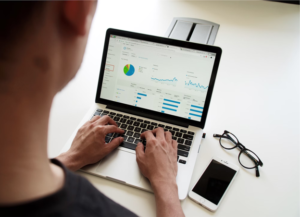Predictive analytics and artificial intelligence (AI) significantly impact our daily lives. And industries like healthcare, banking and finance, automotive, manufacturing, and retail have been utilizing the wonders of AI for more efficient operations.
AI experts have said that this is the start of an era in which AI will handle and oversee everything, making it abundantly evident that AI is not going anywhere.
AI is transforming how businesses operate and make decisions across industries. One of the most important developments of AI is predictive analytics.
Predictive analytics existed before AI in the business world. Before, most businesses’ data was guesswork, and the remaining portion was based on limited observations and prior sales. Market leaders, creators, and scientists have all made assertions in the past based on their particular research. Some of these forecasts materialized, while others did not.
But now, predictive analytics gradually incorporates the subtleties of AI and machine learning. Since it enables companies to use data-driven insights to make educated decisions and optimize their operation, AI-powered predictive analytics will likely revolutionize industries as the technology develops, offering new chances for firms to invest in data-driven decision-making tools.
In this article, we’ll look at AI-powered predictive analytics and the future trends leaders should look out for.

What Is AI-Powered Predictive Analytics?
Predictive analytics is a subset of advanced analytics that uses data, statistical algorithms, and machine learning methods to determine the likelihood of future outcomes based on historical data. It is an effective instrument that helps businesses forecast trends, identify risks, and discover opportunities. Predictive analytics has improved in accuracy and efficiency because of the quick development of AI and machine learning, helping organizations make smarter decisions and remain ahead of the competition.
The growing quantity and variety of data companies have access to is one of the main drivers promoting the development of AI-enabled predictive analytics. Businesses now have data to examine and draw insights from because of the growth of connected devices, social media platforms, and other digital channels. AI-powered predictive analytics systems can quickly process large amounts of data to find patterns and trends humans would be unable to notice.
The demand for real-time decision-making is another factor driving the expansion of AI-powered predictive analytics. Organizations must be flexible and sensitive to shifting market conditions in the fast-paced commercial climate of today. That’s why adopting AI-powered predictive analytics systems in their data transformation strategies is the best option to evaluate data in real-time, giving businesses immediate insights that help them make wise decisions and seize new opportunities.
The Future Trends for AI-Powered Predictive Analytics
Businesses have used the power of predictive analytics in recent years to retain current clients and attract new ones. For the majority of business types, any AI-driven analytical software can predict successes and misses with the help of a data report. But, future trends and technologies can influence the direction of AI-enabled predictive analytics in the future. Here are some of the future trends AI-powered analytics leaders should look out for:
Integration of AI and the Internet of Things (IoT)
AI-powered predictive analytics solutions will be able to analyze data generated because of more connected devices and deliver insightful analysis that leaders can use to improve operations, enhance customer experiences, and drive innovation.
Adoption of Edge Computing
Edge computing refers to the processing of data at the edge of the network that’s nearer the source of the data rather than depending on centralized data centers. The real-time analysis of data made possible by this method minimizes latency, which is essential for AI-powered predictive analytics applications. Businesses can use AI-powered predictive analytics as edge computing becomes more widespread to make quicker, more informed decisions.
Advancements in Natural Language Processing (NLP) And Deep Learning Technologies
AI-powered predictive analytics solutions will progress as NLP and deep learning technology advances. Because of these technologies, AI-powered predictive analytics systems comprehend and analyze unstructured data, such as text, photos, and videos. It will enable organizations to acquire further insights and generate more precise forecasts.
A Promising Future
Even though AI-powered predictive analytics appears to be here to stay, many factors still need to be considered. Successfully implementing new technology in the workplace may be more challenging in many use cases and industries due to factors like data quality, privacy, accountability, and management that we haven’t fully explored. However, the development of intelligent technologies like smart bots and other tools powered by AI has given us hope for a brighter future devoid of tedious and repetitive tasks. It also enables businesses to improve their data security, ultimately helping them achieve a successful SOC 2 compliance. It won’t be long before researchers create something that considers all the mentioned elements. The ultimate goal of AI researchers is to develop a machine with a human-level intellect capable of balancing ethics and pragmatism.
Final Thoughts
Businesses must invest in the appropriate technology and approaches to leverage the power of data-driven decision-making as the future of AI-powered predictive analytics develops. It entails putting money into tools, establishing a data-driven culture, and educating staff members on how to use these technologies. By adopting AI-powered predictive analytics, organizations may seize new possibilities, spur innovation, and dominate the competition in a world that is becoming more and more data-driven.
Author: Bash Sarmiento, Bash Sarmiento Writing
